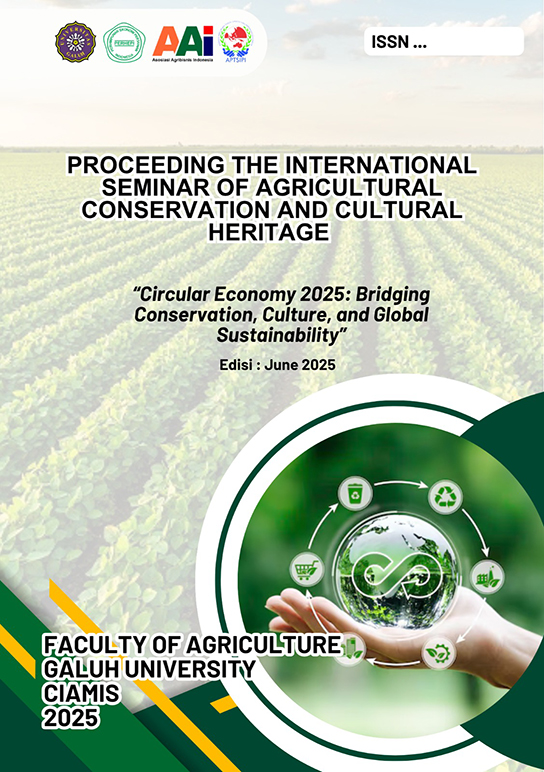GRADING PROCESS OF GOLDEN AROMA MELON COMMODITY IN NAWASENA GREENHOUSE HYDROPONIC IN KARANGNANAS VILLAGE, SOKARAJA DISTRICT, BANYUMAS REGENCY
Keywords:
grading, hydroponic, melonAbstract
Horticultural crops play an important role in Indonesian agriculture. One of the horticultural crops that play an important role is melon. Melon (Cucumis melo L.) is one of the horticultural commodities that has a great opportunity to be developed. The economic value of various types of horticulture depends on the quality of these commodities. Therefore, it is necessary to classify products (grading) based on appearance, sweetness level, color, shape, size, weight, maturity level, and others. The purpose of this research was to find out more about the grading process of golden aroma melon commodities at Nawasena Greenhouse Hydroponic in Karangnanas Village, Sokaraja District, Banyumas Regency. The method used in the research is a qualitative method with a descriptive analysis approach. The results showed that the grading process every harvest is by conducting a grading test for each segment of the melon plant or it can be said to be a sample of each segment.
References
Suryawaty and R. Wijaya, “Respon Pertumbuhan DanProduksi Tanaman Melon (Cucumis Melo L.) Terhadap Kombinasi Biodegradable Super Absorbent Polymer Dengan Pupuk Majemuk NPK Di Tanah Miskin Hara,” Agrium, vol. 17, no. 3, pp. 155–162, 2012.
R. D. Cahyani, K. Hidayat, and A. Kustanti, “ADOPTION OF MELON (Cucumis melo L.) CULTIVATION INNOVATIONS WITH GREENHOUSE TECHNOLOGY IN WATES DISTRICT, BLITAR REGENCY,” Ekon. Pertan. dan Agribisnis, vol. 8, no. 2, pp. 579–589, 2024, [Online]. Available: https://doi.org/10.21776/ub.jepa.2024.008.02.14
A. N. Huda, W. B. Suwarno, and D. A. Maharijaya, “Characteristics of Melon (Cucumismelo L.) Fruits at Five Maturity Stages,” Indones. J. Agron., vol. 46, no. 3, pp. 298–305, 2019.
A. Muspiah, N. I. Julisaniah, B. Farista, K. Sukenti, R. Amrulloh, and S. I. Suci, “Analysis of The Effectiveness of Cultivating Melon (Cucumis melo L.) on Hydroponic Cultivation Methods and Conventional Drip Irrigation Semi-Closed Systems,” J. Biol. Trop., vol. 24, no. 2, pp. 511–515, 2024, doi: 10.29303/jbt.v24i2.6716.
U. & V. Aimannah, Buku Petunjuk Praktikum: Teknologi Penanganan dan Pengolahan Hasil Pertanian. 2019.
M. H. Ndapamuri, M. P. Epa, V. U. T. Andung, and U. William, “SISTEM PENANGANAN PASCA PANEN PADI DI KECAMATAN LEWA,” vol. 7, no. 2, pp. 32–38, 2022.
E. & Y. Astarina, METODOLOGI PENELITIAN, Ed. I. Cet. Yogyakarta: Penerbit ANDI OFFSET, 2021.
Y. Apriyanti, E. Lorita, and Y. Yusuarsono, “Kualitas Pelayanan Kesehatan Di Pusat Kesehatan Masyarakat Kembang Seri Kecamatan Talang Empat Kabupaten Bengkulu Tengah,” Prof. J. Komun. dan Adm. Publik, vol. 6, no. 1, 2019, doi: 10.37676/professional.v6i1.839.
H. Patilima, METODE PENELITIAN KUALITATIF. Bandung: ALFABETA, cv, 2011.
D. Rika Widianita, “SYSTEMATIC LITERATURE REVIEW (SLR): BIG DATA ANALYTICS FOR A SMARTER FUTURE,” AT-TAWASSUTH J. Ekon. Islam, vol. VIII, no. I, pp. 1–19, 2023.
Asiva Noor Rachmayani, PENANGANAN PASCA PANEN DAN PEMASARAN HASIL PERTANIAN. Kalimantan Selatan: Balai Pengkajian Teknologi Pertanian Kalimantan Selatan, 2022


